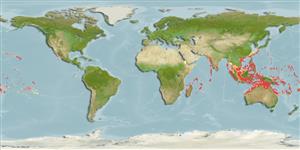Environment: milieu / climate zone / depth range / distribution range
Ecologie
marien; brak water rifbewoner; diepte 1 - 80 m (Ref. 90102). Tropical; 35°N - 25°S
Pacific Ocean: northwest Australia, Moluccas, and Philippines to the Marquesan and Society islands, north to Ryukyu Islands, south to Rowley Shoals, Western Australia, and Tonga; Mariana and Caroline Islands in Micronesia.
Grootte / Gewicht / Leeftijd
Maturity: Lm ? range ? - ? cm
Max length : 13.6 cm TL mannelijk / geslacht onbekend; (Ref. 90102); common length : 10.4 cm SL mannelijk / geslacht onbekend; (Ref. 37816)
Dorsale stekels (totaal) : 12; Dorsale zachte stralen (totaal) : 9; Anale stekels: 3; Anale zachte stralen: 5. Submarginal black band on inner pectoral fin surface complete; eyes relatively large; snout relatively short; hump on back less obvious as in S. diabolus; SL to 10.4 cm. No black spot nearly as large as eye on inner surface of pectoral fins. A narrow triangular black mark inside mouth at front of upper jaw behind teeth. Ascending process of premaxilla broad, its maximum width 1.4-1.8 in orbit diameter. No series papillae or nodules across interorbital space between supraocular spines. Nasal spine single (Ref 42181).
A rare inhabitant of mixed sand and rubble areas of reef flats and shallow lagoons. Feeds on fishes (Ref. 89972). Usually buries itself in the substrate when in sand or sits amongst rubble where it has good camouflage (Ref. 48635). Anterolateral glandular grooves with venom gland (Ref. 57406). Solitary or in pairs (Ref 90102).
Levenscyclus en paargedrag
Maturiteit | Voortplanting | Paaien | Eieren | Fecunditeit | Larven
Myers, R.F., 1991. Micronesian reef fishes. Second Ed. Coral Graphics, Barrigada, Guam. 298 p. (Ref. 1602)
Status op de Rode Lijst van het IUCN (Ref. 130435: Version 2024-1)
Gebruik door de mens
Tools
Speciale rapporten
Download XML
Internetbronnen
Estimates based on models
Preferred temperature (Ref.
123201): 25 - 28.9, mean 27.7 °C (based on 672 cells).
Fylogenetische diversiteitsindex (Ref.
82804): PD
50 = 0.5000 [Uniqueness, from 0.5 = low to 2.0 = high].
Bayesian length-weight: a=0.01288 (0.00620 - 0.02676), b=3.03 (2.86 - 3.20), in cm total length, based on LWR estimates for this (Sub)family-body shape (Ref.
93245).
Trofisch niveau (Ref.
69278): 3.9 ±0.7 se; based on size and trophs of closest relatives
Weerstandsvermogen (Ref.
120179): Hoog, minimale populatieverdubbelingstijd minder dan 15 maanden (Preliminary K or Fecundity.).
Fishing Vulnerability (Ref.
59153): Low vulnerability (10 of 100).
Nutrients (Ref.
124155): Calcium = 86.4 [42.3, 185.0] mg/100g; Iron = 0.783 [0.399, 1.637] mg/100g; Protein = 18.2 [16.1, 20.2] %; Omega3 = 0.272 [0.111, 0.722] g/100g; Selenium = 25.5 [12.1, 60.9] μg/100g; VitaminA = 249 [79, 763] μg/100g; Zinc = 1.67 [1.10, 2.46] mg/100g (wet weight);
